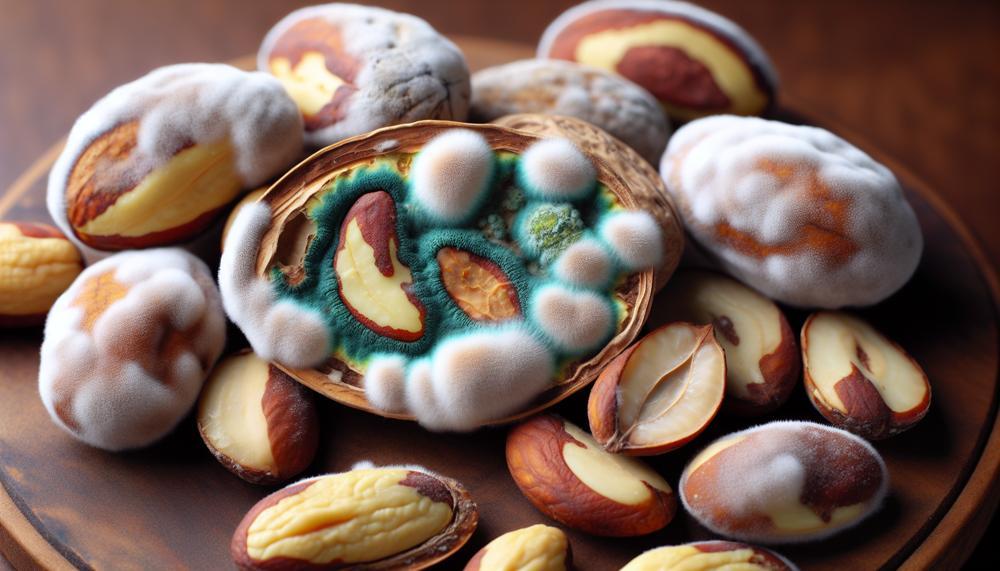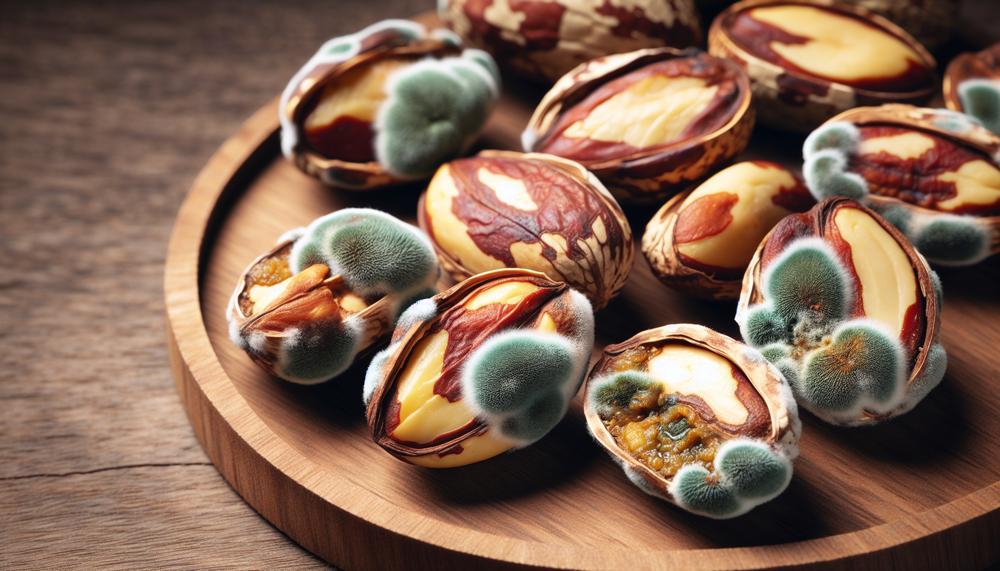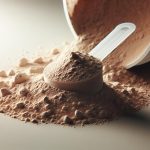Have you ever tasted a Brazil nut and thought, “Why does this taste moldy?” Well, you’re not alone. Despite their popularity and nutritional benefits, Brazil nuts have a distinct flavor that can be described as buttery, slightly sweet, and yes, even a hint of bitterness. But what makes them so unique?
In this blog post, we’ll delve into the world of Brazil nuts and uncover the secrets behind their delicious taste.
First off, let’s talk about texture. These large, crescent-shaped nuts are often described as having a “creamy” texture that adds richness to any dish. This is due to their high levels of healthy fats, including monounsaturated and polyunsaturated fats. Not only do these fats contribute to the creamy texture but they also offer numerous health benefits.
But it’s not just about the fats. Brazil nuts are also packed with essential nutrients such as protein, fiber, selenium, magnesium, and zinc. This powerhouse combination makes them a staple food in South America for centuries.
Now that we know why Brazil nuts taste so good let’s explore how they can be enjoyed. They make for a perfect snack on their own or can be incorporated into various recipes like salads or granola bars. And for our vegan friends out there looking for a dairy substitute, look no further than Brazil nuts.
Thanks to their rich flavor and nutritional value, Brazil nuts have gained popularity worldwide and can now be found in most supermarkets. So next time you’re looking to add some variety to your diet or simply want to try something new and delicious – don’t forget about these amazing nuts.
Intrigued? Keep reading to discover more about the unique flavor of Brazil nuts and how they can elevate your culinary experience.
Contents
What Does Mold On Brazil Nuts Look Like
Mold on Brazil nuts can manifest as black or greenish-black spots with a fuzzy or powdery texture. This is caused by the fungus Aspergillus flavus, which thrives in warm and humid environments. The contamination of molds that produce toxins like aflatoxin can also cause this mold.
To recognize mold on Brazil nuts, look for discolored areas with a fuzzy or powdery texture. These spots may also have a slightly raised appearance or feel slimy. If the nuts have an off-putting or musty odor, it could also be a sign of mold growth.
Inspecting Brazil nuts for any signs of mold before consuming them is crucial. If you notice any of these indications, it is best to discard the nuts immediately to avoid potential health hazards. Consuming moldy Brazil nuts can lead to respiratory illness, gastrointestinal distress, and even death.
Proper storage is essential in preventing mold growth on Brazil nuts. Keep them in a cool and dry place and consume them within a few months. Freezing the nuts can also extend their shelf life.
It is also important to wash your hands before handling the nuts and use an airtight container for storage.
The Dangers Of Mold On Brazil Nuts
The growth of mold on Brazil nuts is caused by a combination of two factors: high humidity and extended storage times.
This allows the fungus Aspergillus flavus to thrive, as it prefers warm and humid environments. Therefore, Brazil nuts are at a higher risk for mold growth compared to other foods.
However, consuming moldy Brazil nuts can have serious consequences such as respiratory illness, digestive problems, and even death due to the presence of the toxic mycotoxin aflatoxin.
What Causes Mold On Brazil Nuts?
Brazil nuts are prone to developing mold, which is caused by the presence of a fungus called Aspergillus flavus. This fungus thrives in warm and humid environments, making it a common occurrence in these types of climates.
The growth of this mold can produce harmful toxins known as aflatoxins, which can pose serious health risks to consumers. Factors such as high humidity levels and extended storage periods can contribute to the development of mold on Brazil nuts.
To prevent this, it’s important to store them properly by keeping them in a cool and dry place and consuming them within a few months.
Signs that Brazil nuts have spoiled include shriveling, rancidity, changes in color, and a stale taste. If any of these signs are present, it is crucial to discard the nuts immediately to avoid potential health hazards.
Anecdote:
I once had a bag of Brazil nuts that I stored in my pantry for over six months. When I finally decided to crack them open, I noticed a musty odor and dark spots on the nuts’ surface.
Being unaware of the potential dangers, I still ate a few and ended up with a severe case of food poisoning. Little did I know that the fungus Aspergillus flavus had grown on the nuts due to their prolonged storage time in warm and humid conditions.
From then on, I made sure to consume my Brazil nuts within a few months of purchase and store them in a cool and dry place.
Preventing mold on Brazil nuts is crucial not only for their taste but also for our health. The presence of aflatoxins can lead to liver damage and even cancer if consumed regularly over time. So it is essential to pay attention to proper storage practices and signs of spoilage when consuming Brazil nuts.
Keeping them in a cool and dry place will help maintain freshness, while consuming them within a few months will prevent the growth of mold and potential health risks.
How To Spot Mold On Brazil Nuts
When attempting to identify mold on Brazil nuts, there are a few visual indicators to be aware of. These include:
Black or greenish-black spots
Mold on Brazil nuts can manifest as dark spots on the surface of the nut. These spots may have a fuzzy or powdery texture.

Changes in color and texture
Mold has the ability to alter the color of Brazil nuts from their usual light brown to a darker hue. The texture of the nut may also become soft and mushy.

Shriveling and wrinkles
As mold develops, Brazil nuts may shrivel and develop wrinkles on their surface.
Rancidity
Moldy nuts may emit a rancid or musty odor, indicating spoilage.
Stale taste
Consuming moldy Brazil nuts can result in an unpleasant, stale taste.
It is crucial to thoroughly examine Brazil nuts before consuming them, as mold growth can be detrimental to one’s health.
Along with these visual cues, it is also important to practice proper storage techniques, such as using sealed containers and storing them in a cool, dry place.
Other Signs Of Spoiled Brazil Nuts
Other indications of spoiled Brazil nuts include changes in color, withering or wrinkling of the skin, and an unpleasant or rancid smell and taste. These indications may signal that the nuts have turned bad and should not be consumed.
Additionally, Brazil nuts have a high oil content which makes them more susceptible to spoilage when exposed to heat and air. This means that they have a shorter shelf life compared to other nuts, lasting only about 6 months at room temperature and up to a year when refrigerated.
Aside from appearance and taste, it is crucial to also pay attention to the potential health hazards associated with consuming spoiled Brazil nuts. These nuts contain elevated levels of selenium which can be toxic in large quantities.
Ingesting rancid Brazil nuts can lead to digestive issues and other detrimental effects on overall health. It is recommended to limit consumption and properly store Brazil nuts in an airtight container in a cool, dry place.
If you happen to come across a batch of stale Brazil nuts, there are ways to revive them. Roasting or soaking them in water can help bring back their freshness. Adding flavor through spices or honey can also help conceal any rancid taste.
However, if there are signs of mold or a strong unpleasant smell, it is best to dispose of them to avoid potential food poisoning. By being aware of these indications and correctly storing Brazil nuts, you can ensure that your consumption of this nutrient-rich nut is safe and enjoyable.
Moreover, storing Brazil nuts properly can also enhance their longevity and preserve their quality. Keeping them away from heat and air exposure can prevent spoilage and maintain their freshness for a longer period of time.
How To Store Brazil Nuts To Prevent Mold Growth
Storing Brazil nuts properly is crucial to prevent mold growth and ensure their freshness. To keep your nuts mold-free, follow these storage methods:
| Storage Method | Details |
| Airtight Container | Place your Brazil nuts in an airtight container to shield them from moisture and humidity. |
| Refrigeration | If you plan on keeping your nuts for an extended period, store them in the refrigerator to maintain their freshness and avoid mold growth. |
| Freezing | You can also freeze your Brazil nuts in an airtight container or freezer bag to prolong their shelf life. |
| Proper Handling | To prevent contamination, always wash your hands and sanitize containers before handling and storing your Brazil nuts. |
It’s important to keep in mind that even with proper storage methods, mold growth on Brazil nuts may still occur. That’s why it’s crucial to inspect the nuts for any signs of mold before consuming them.
If you notice any black or greenish-black spots with a fuzzy or powdery texture, it’s best to discard the nuts immediately to avoid potential health risks.
Furthermore, it’s essential to avoid eating nuts that are discolored or damaged. These could be indications of spoilage and may contain harmful toxins like aflatoxins and mycotoxins. These toxins can cause severe health problems, especially for those with weakened immune systems.
When To Discard Moldy Brazil Nuts
Brazil nuts are a dense source of nutrients and a delicious treat, but like any other food, they can spoil. It’s crucial to be able to identify the indications of spoilage in Brazil nuts to prevent consuming them when they are no longer safe. Here’s how you can tell if Brazil nuts have gone bad and should be discarded:
Shriveled appearance: A Brazil nut that has gone bad may look shriveled and have wrinkled skin.
- Changes in color: Fresh Brazil nuts have a light brown color, but if they have spoiled, they may turn brown or black.
- Off odor: Spoiled Brazil nuts may emit an unpleasant smell that is different from their usual nutty aroma.
- Stale taste: If you take a bite of a Brazil nut and notice a stale or rancid taste, it’s likely that the nut has gone bad.
If you observe any of these signs, it’s best to discard the Brazil nut to avoid potential health risks.
Conclusion
In conclusion, Brazil nuts possess a one-of-a-kind flavor profile that can be described as rich, buttery, and slightly sweet with a hint of bitterness. This is due to their high content of healthy fats and essential nutrients such as protein, fiber, selenium, magnesium, and zinc. While their taste may be delectable, it’s crucial to store them correctly to prevent mold growth.
Mold on Brazil nuts can manifest as dark black or greenish-black spots with a fuzzy or powdery texture. This is caused by the fungus Aspergillus flavus which produces harmful toxins like aflatoxin. Signs of spoilage include changes in color and texture, shriveling and wrinkles, rancidity, and an off-putting taste.
To avoid mold growth on Brazil nuts, proper storage is key. It’s important to keep them in an airtight container in a cool and dry place.
Additionally, handling techniques must be followed carefully to prevent contamination. If any signs of mold or spoilage are detected, it’s best to discard the nuts immediately to avoid potential health risks.
In summary, Brazil nuts offer a plethora of nutrients and a unique flavor but must be stored correctly to maintain their freshness and safety for consumption.




